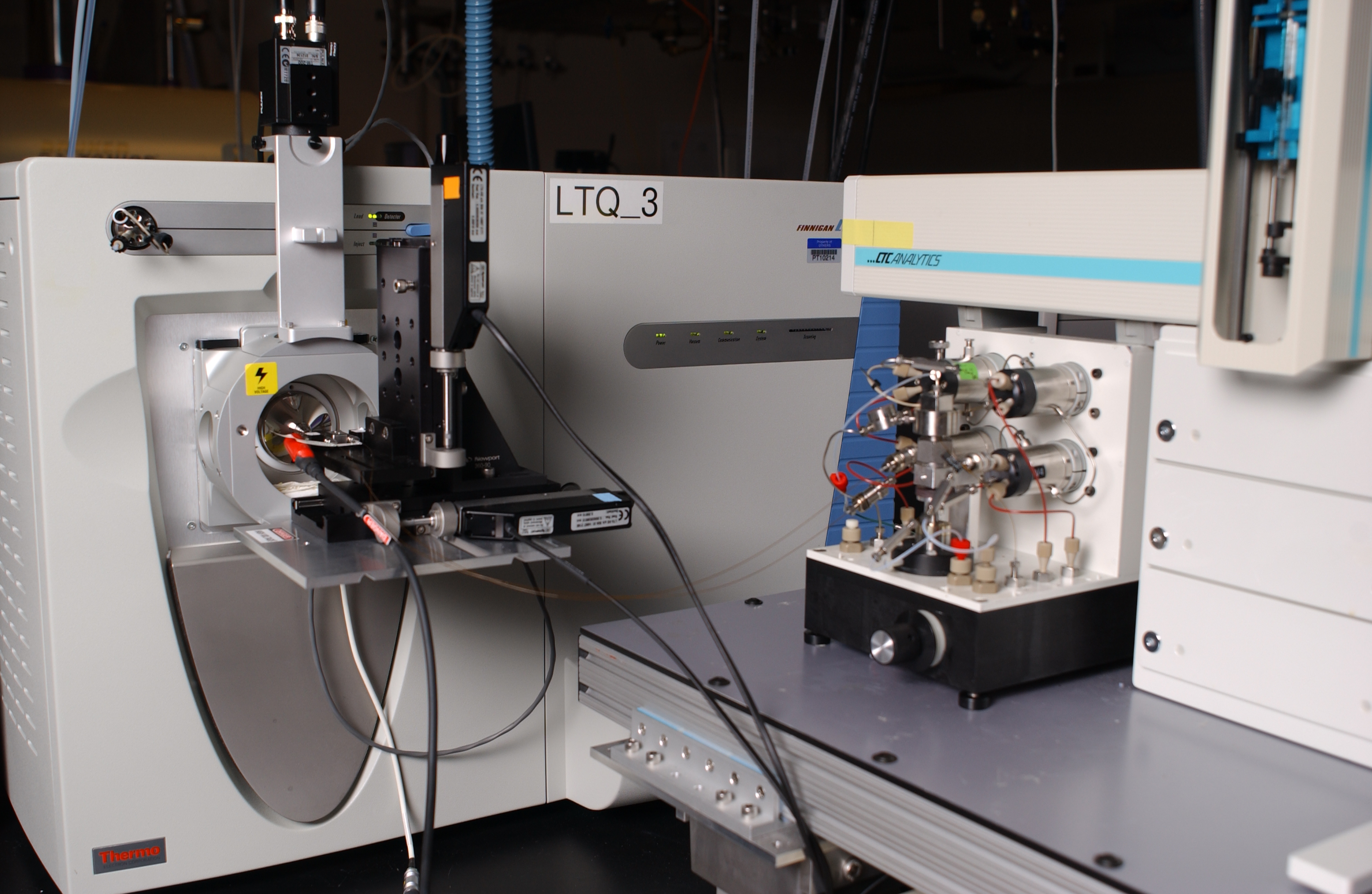- Liquid chromatography-mass spectrometry
Infobox chemical analysis
name = Liquid chromatography-mass spectrometry

caption =Ion trap LCMS system
acronym = LCMS
classification =Chromatography Mass spectrometry
analytes =organic molecule sbiomolecule s
manufacturers =Agilent
Bruker
MDS
Shimadzu Scientific
Thermo Fisher Scientific
Varian, Inc.
Waters Corporation
related =Gas chromatography-mass spectrometry
hyphenated =Liquid chromatography-mass spectrometry (LC-MS) is an
analytical chemistry technique that combines the physical separation capabilities of liquid chromatography (or HPLC) with the mass analysis capabilities ofmass spectrometry . LC-MS is a powerful technique used for many applications which has very high sensitivity and specificity. Generally its application is oriented towards the specific detection and potential identification of chemicals in the presence of other chemicals (in a complex mixture).Liquid chromatography
cale
A major difference between traditional
HPLC and thechromatography used in LC-MS is that in the latter case the scale is usually much smaller, both with respect to the internal diameter of the column and even more so with respect to flow rate since it scales as the square of the diameter. For a long time, 1 mm columns were typical for LC-MS work (as opposed to 4.6 mm for HPLC). More recently 300m and even 75m capillary columns have become more prevalent. At the low end of these column diameters the flow rates approach 100nL/min and are generally used withnanospray sources. [ [http://dx.doi.org/10.1002/mas.1280130504 Capillary liquid chromatography/mass spectrometry, Kenneth B. Tomer, M. Arthur Moseley, Leesa J. Deterding, Carol E. Parker, Mass Spectrometry Reviews, Vol 13, 1994, pp 431-457] ]Flow splitting
When standard
bore (4.6 mm) columns are used the flow is often split ~10:1. This can be beneficial by allowing the use of other techniques in tandem such as MS and UV. However splitting the flow to UV will decrease the sensitivity of spectrophotometric detectors. The Mass Spec on the other hand will give improved sensitivity at flow rates of 200 μL/min or less. This is because the analyte ions have to be vaporised (nebulized) in order to become charged.Mass spectrometry
Mass analyzer
There are a lot of mass analyzers that can be used in LC/MS. Single Quadrupole, Triple Quadrupole, Ion Trap, TOF (time of Flight) and Quadrupole-time of flight (Q-TOF).
Interface
Understandably the interface between a liquid phase technique which continuously flows liquid, and a gas phase technique carried out in a vacuum was difficult for a long time. The advent of
electrospray ionization changed this. The interface is most often anelectrospray ion source or variant such as a nanospray source; howeverfast atom bombardment ,thermospray andatmospheric pressure chemical ionization interfaces are also used. [ [http://dx.doi.org/10.1002/mas.1280110103 Combined liquid chromatography mass spectrometry. Part III. Applications of thermospray, Patrick Arpino, Mass Spectrometry Reviews, Vol 11, 1992 pp 3-40] ] Various deposition and drying techniques have also been used such as using moving belts; however the most common of these is off-lineMALDI deposition. [Combined liquid chromatography mass spectrometry. Part I. Coupling by means of a moving belt interface, Patrick Arpino, Mass Spectrometry Reviews, Vol 8, 1989 pp 35-55] [ [http://www3.interscience.wiley.com/cgi-bin/abstract/10009479/ABSTRACT Coupling matrix-assisted laser desorption/ionization to liquid separations, Kermit K. Murray, Mass Spectrometry Reviews, Vol 16, pp 283-299] ]Applications
Pharmacokinetics
LC-MS is very commonly used in
pharmacokinetic studies of pharmaceuticals. These studies tell us how quickly a drug will be cleared from the hepatic blood flow, and organs of the body. MS is used for this due to high sensitivity and exceptional specificity compared to UV (as long as the analyte can be suitably ionised), and short analysis time.The major advantage MS has is the use of tandem MS-MS. You can program the detector to select certain ions to fragment. The process is essentially a selection technique, but is in fact more complex. The measured quantity is the sum of molecule fragments chosen by the operator. As long as there are no interferences or ion suppression, the LC separation can be quite quick. It is common now to have analysis times of 1 minute or less by MS-MS detection, compared to over 10 mins with UV detection. [Increasing Speed and Throughput When Using HPLC-MS/MS Systems for Drug Metabolism and Pharmacokinetic Screening, Y. Hsieh and W.A. Korfmacher, Current Drug Metabolism Volume 7, Number 5, 2006, Pp. 479-489] [Covey TR, Lee ED, Henion JD. 1986. High-speed liquid chromatography/tandem mass spectrometry for the determination of drugs in biological samples. Anal Chem 58:2453-2460.] [Thermospray liquid chromatography/mass spectrometry determination of drugs and their metabolites in biological fluids. Covey TR et al. Anal Chem. 1985 Feb;57(2):474-81]
Proteomics
LC-MS is also used in the study of
proteomics where again components of a complex mixture must be detected and identified in some manner. Thebottom-up proteomics LC-MS approach to proteomics generally involves protease digestion (usuallyTrypsin ) followed by LC-MS withpeptide mass fingerprinting or LC-MS/MS (tandem MS) to derive sequence of individual peptides.Drug development
LC-MS is frequently used in drug development at many different stages including Peptide Mapping, Glycoprotein Mapping, Natural Products Dereplication, Bioaffinity Screening, In Vivo Drug Screening, Metabolic Stability Screening, Metabolite Identification, Impurity Identification, Degradant Identification, Quantitative Bioanalysis, and Quality Control. [ [http://www3.interscience.wiley.com/cgi-bin/abstract/66004558/ABSTRACT LC/MS applications in drug development, Mass Spectrometry Reviews, Mike S. Lee, Edward H. Kerns, Vol 18, 1999, pp 187-279] ]
ee also
*
Gas chromatography-mass spectrometry
*Ion mobility spectrometry-mass spectrometry References
Bibliography
*cite book |author=Thurman, E. M.; Ferrer, Imma |title=Liquid chromatography/mass spectrometry, MS/MS and time of flight MS: analysis of emerging contaminants |publisher=American Chemical Society |location=Columbus, OH |year=2003 |pages= |isbn=0-8412-3825-1 |oclc= |doi=
*cite book |author=Ardrey, R. E.; Ardrey, Robert |title=Liquid chromatography-mass spectrometry: an introduction |publisher=J. Wiley |location=London |year=2003 |pages= |isbn=0-471-49801-7 |oclc= |doi=
*cite book |author=McMaster, Marvin C. |title=LC/MS: a practical user's guide |publisher=John Wiley |location=New York |year=2005 |pages= |isbn=0-471-65531-7 |oclc= |doi=
*cite book |author=Wilfried M.A. Niessen, Wilfried M. Niessen |title=Liquid Chromatography-Mass Spectrometry, Third Edition (Chromatographic Science) |publisher=CRC |location=Boca Raton |year= 2006 |pages= |isbn=0-8247-4082-3 |oclc= |doi=
*cite book |author=Yergey, Alfred L. |title=Liquid chromatography/mass spectrometry: techniques and applications |publisher=Plenum Press |location=New York |year=1990 |pages= |isbn=0-306-43186-6 |oclc= |doi=
Wikimedia Foundation. 2010.
